Greetings and welcome to the latest edition of our Positive and Negative Regression report. You’ve made it to the end of August, which in 2020 means that it’s probably right around the trade deadline in your league.
The MLB trade deadline is Monday, August 31, and many fantasy leagues chose to mirror that this season. That means you are now relying on last-ditch trade efforts before your only option is the waiver wire for the rest of the season.
And by the time you read this, it might already be too late for trades. So, we’ll make this edition of Regression Candidates a conversation about both trade and waiver wire options.
Import your team to My Playbook for instant Lineup & Trade advice ![]()
Negative Regression Candidates
Zach Davies (SP – SD)
Davies has been pitching like a man on fire this season. Through seven starts, he is 5-2 with a 2.61 ERA, a 0.90 WHIP, and 37 strikeouts over 41 1/3 innings. It looks like he has turned a corner in his first season with the Padres.
His strikeouts are up. His walks are down. Home runs are down. At first glance, there aren’t a ton of red flags. Maybe this is legit? Let’s take a closer look.
At least some oof Davies’s early success is likely due to a new approach. Take a look at his Pitch% chart:

He isn’t entirely ditching the sinker, but its usage is way down. He’s relying on his changeup and cutter more. And so far, it’s hard to argue with the results. Hitters are batting just .187 against all of his pitches combined and just .176 and .179 against the changeup and cutter, respectively.
But here’s the thing. While his expected numbers (FIP = 3.25, xFIP = 3.99, xERA = 4.43) don’t indicate massive regression, they do call for some bumps in the road ahead. And here is why.
While Davies is missing more bats, he still isn’t missing very many. His Whiff% is in the 30th percentile, and while he has solid Hard Hit and Exit Velocity numbers, his Barrel% is also in the 20th percentile. His .220 BABIP indicates some luck, but he has also earned some of that luck so far by limiting the hard contact.
But we know who Davies is at this point. His fastball sits in the upper 80s on a good day, and he has the odd combination of being a pitcher who relies on movement without a good breaking ball. He’s a smoke and mirrors sinker-cutter-changeup pitcher, which his chart above indicates.
In today’s MLB, pitchers who don’t miss a lot of bats tend to run into trouble sooner or later. And while Davies probably isn’t going to fall off to the point of having to be dropped in all formats, he is likely headed for some regression.
See if you can trade him to a pitcher-needy owner for a bat that will help you down the stretch at the deadline. If you can’t, it’s not the end of the world. Just know you probably aren’t going to keep getting a sub-3.00 ERA from Davies the rest of the way.
Yandy Diaz (1B, 3B, DH - TB)
I take no pleasure in writing this because I love me some Yandy Diaz. And he’s also doing some good things at the plate, so it’s not all bad. His walks are WAY up: 10.1% in 2019 to 17.0% in 2020. That’s the ninth-best number in all of baseball.
If you’re in an OBP league, you can stop reading now because you’re going to be OK with Diaz’s .422 OBP. Just kidding. Please keep reading.
The problem is what happens when Diaz does swing the bat. You may look at his numbers, see just two home runs in 33 games this season after he hit 14 home runs in 79 last season, and think to yourself: I bet more home runs are on the way in the second half.
They aren’t. Let’s start by taking a look at his HR/FB and FB % numbers:
- 2019: 17.5% HR/FB vs. 32.0% FB %
- 2020: 18.2% HR/FB vs. 11.7% FB %
If you’re wondering if an 11.7 flyball percentage is bad, it is. At least in terms of home run potential. His HR/FB percentage is high simply because he just doesn’t put the ball in the air. That helps explain why he is slugging just .378 on the season.
This Average Launch Angle chart should help, too:
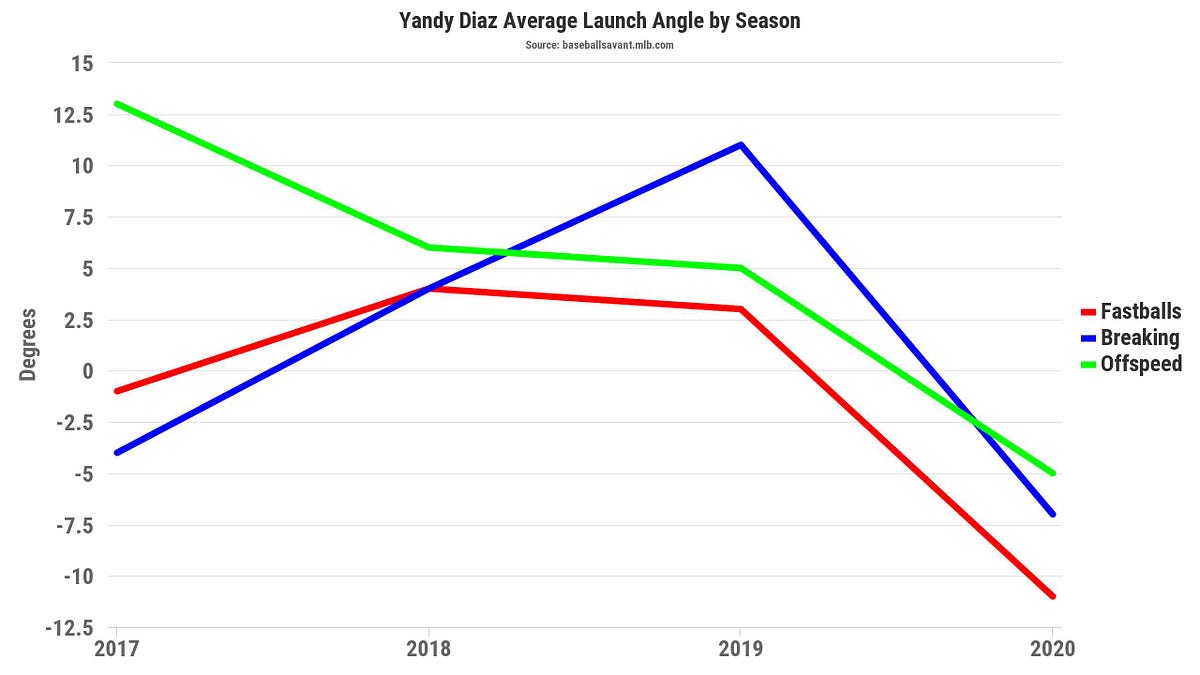
If you look at those numbers on the left side of the chart, they are indeed in the negatives. His average launch angle this season is -8.3. The league average is around 12 (and that’s a positive 12, not a negative one).
In 2019, despite still having a below-average launch angle (not in the negatives low, but still below average), he was tearing the cover off the ball:

And despite the solid batting average and on-base numbers in 2020, this helps explain why he only has a handful of extra-base hits this season:
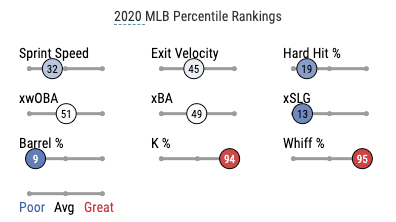
Diaz is probably going to continue getting on base, and he has some value as long as he keeps doing that and continues to bat near the top of the Tampa Bay lineup. But that power you are hoping for probably isn’t coming.
Positive Regression Candidates
Eduardo Escobar (2B, 3B, SS – ARI)
I don’t think we’re getting 35 home runs from Escobar again this season. Or the 60-game equivalent of about 13. Through 34 games, Escobar is batting .200 with 16 runs scored, four home runs, 16 RBI, and one stolen base.
His ownership has fallen below 80%, and it would likely be even lower if not for his positional eligibility. But could he be in line for some positive regression in the second half? Let’s take a quick look.
His batted ball numbers are what I like to call “Very OK,” other than his Hard Hit number, which isn’t great:
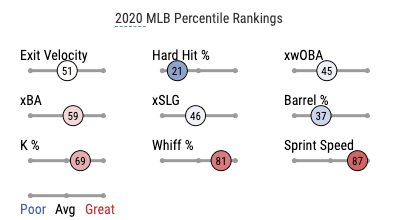
But check this out. They weren’t all that great last season, either. In fact, they were worse:
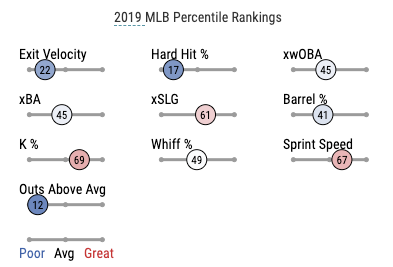
In 2020, his walks are up, strikeouts are slightly down, and most of his batted ball numbers are the same or better. So, what gives? For starters, his SLG is down to .350 from last season’s .511. And while he wasn’t likely to repeat that .511 number, his career average is .433.
And while it hasn’t all been bad luck, some of it has been mixed in. His .215 BABIP indicates some bounces not going his way, and his career number there is .293. Likewise, his .267 wOBA is in the bottom 7% of baseball, but his .349 xWOBA is much more palatable.
The Diamondbacks being in sell mode makes things interesting, and that could have a positive or negative effect on Escobar. But in any event, it looks like he is due for at least some positive regression and better luck in the second half.
Zach Eflin (SP – PHI)
Eflin may not technically qualify as a positive regression candidate because he has already been pitching fairly well of late. But I make the rules here, so we’re going with it. His ownership is all over the place in different formats, so it seems as if many fantasy owners are unsure of what to do with him.
Eflin has made a number of adjustments under the Joe Girardi regime, especially when it comes to his pitch mix. This is only a five-game sample size, but look at the dramatic shift in pitch usage:
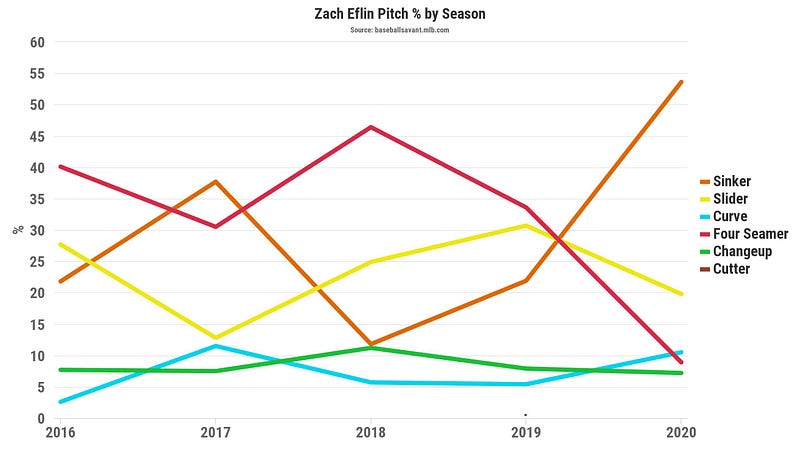
Eflin appears to have ditched his four-seamer in favor of his sinker in a big way. And through five starts, it seems like he might be onto something. His 2020 Statcast numbers through 26 1/3 innings:
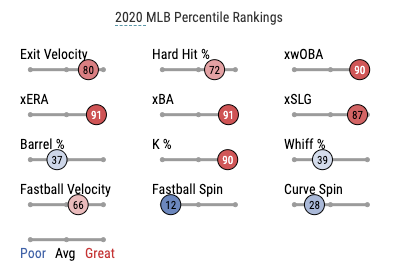
What’s even better is he is doing this with a .365 BABIP, and his FIP (2.71), xFIP (3.03), and xERA (2.64) all agree that he should be even better down the stretch.
If you’re looking for a starter for the back-end of your staff for the second half, see if Eflin is available in your league. This new-look Eflin is missing bats and limiting damage, and he could be solid down the stretch if he can limit the free passes.
View your league’s top available players with My Playbook ![]()
Subscribe: Apple Podcasts | Spotify | Google Podcasts | Stitcher | SoundCloud | iHeartRadio
Whether you’re new to fantasy baseball or a seasoned pro, our Fantasy Baseball 101: Strategy Tips & Advice page is for you. You can get started with our Sabermetrics Glossary or head to more advanced strategy – like How to Make Custom Fantasy Baseball Rankings with Microsoft Excel – to learn more.
Mike Maher is a featured writer at FantasyPros. For more from Mike, check out his archive and follow him on Twitter @mikemaher

